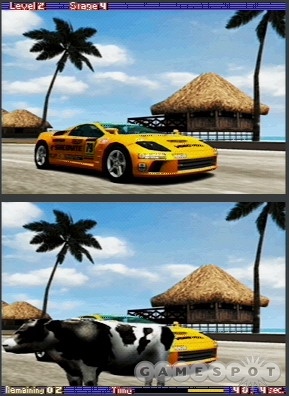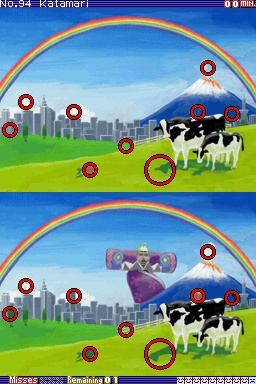How much fun can you have looking at two pictures and spotting the subtle differences between them? You'd best hope the answer to that question is "a whole heck of a bunch" if you plan to invest in Namco Bandai's QuickSpot for the DS. It's just about the simplest premise in the world, revolving exclusively around variations on the aforementioned descriptor. Sometimes the images animate, sometimes they're upside down, and sometimes there are multiple differences between the same two images, but the underlying concept remains the same all throughout. At least QuickSpot won't cost you much, and it does have some reasonably solid multiplayer. But once you've played for a couple of hours and blasted through the bulk of the game's available images, you'll have had your fill.

The primary single-player mode in QuickSpot is a rapid-play mode that puts you through a progression of stages, each of which tasks you with spotting a set number of differences before time runs out. These get progressively more obscure as time goes on, and at the final level for each stage, there's a "boss" stage. This stage flips the script a bit and has you wiping away a bunch of crud with the stylus so you can see what's on the second screen or blowing into the DS's microphone to float a bunch of leaves off the second screen, all while still under a time limit. Other than these few changes, you don't do much in QuickSpot apart from drawing circles around things. Even the menus require you to draw circles around the start button or other various options to continue. In gameplay, you simply spot the difference between the two presented images and draw a circle around it. That's pretty much it.
You can blow through the first set of stages in about an hour, though there are some new stages and challenges that unlock as you progress. However, within that first hour, you'll have seen practically every image the game has to offer. Granted, many images have several available differences that alternate depending on the stage and relative difficulty level, but after a while you will start seeing a lot of repeats. The added challenges, such as the animated images, add some value to the mode, but the fun wears thin relatively quickly. The only other motivation to continue playing through the mode is a weak brain-training angle that judges you in a few specific categories, such as concentration and judgment. The trouble is that it's never clear exactly how you're being judged in a lot of these categories. There are times when you might screw up royally but only lose a bit, and then there are times when you think you did really well, but you'll see decreases in certain categories and increases in others. The mode seems kind of tacked on because it's not very well spelled out.
Beyond that mode, there's a concentration mode that nixes the time limit and tasks you with spotting 10 differences in a single set of images; a fortune mode that tells you your fortune in money, health, romance and work, based solely on which individual differences you spot in the images it presents you; and a multiplayer mode that's both multicard and download play. The multiplayer modes are probably the best thing QuickSpot has going for it. Time bomb is a hot-potato-esque mode where up to eight people can play on a single DS. You simply pass the DS around to the next player once you've solved the current puzzle, and the one left holding the DS when the bomb explodes loses. Scramble mode is a multi-DS mode that has you and up to three others competing at the same puzzles. The one who circles the fastest is the winner, but those on the losing end can eventually build up a meter that gives them access to some unique power-ups, which can turn an opponent's screen into a negative view or obscure an opponent's screen by sending crazy frogs across the screen. The novelty of this mode wears thin after a while, but it's inherently more fun to play these puzzles with others along for the ride.

At least QuickSpot does a solid job of presenting itself. A good chunk of the puzzle images are culled from various Namco Bandai brands, so you'll see Pac-Man, Katamari Damacy, and other, similarly familiar games pop up now and again. The rest are mostly a peculiar variety of anime drawings and sketches, as well as a few random claymation shots and other strange pieces of artistry. Even though there's very little animation and you are basically staring at still frame shots over and over again, the game presents a good look. All the images are also pretty crisp and colorful. The audio doesn't consist of more than a bunch of hypercheery MIDI tunes that are either going to be catchy or painful, depending on your disposition.
At $20, QuickSpot isn't a terrible investment for those in need of some kind of new, simplistic distraction to go with their DSs. Just be aware going in that the novelty of the concept and the game's execution of it won't last beyond a few reasonably enjoyable hours.